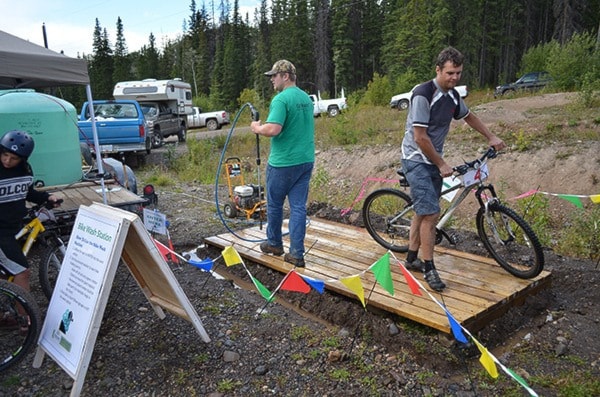While many mountain bikers at the recent Big Pig Mountain Biking Festival in Burns Lake appreciated the bike wash station available in the Kager Lake recreation site parking lot, they may not have realized that keeping bikes clean after a day of riding was only one aspect of the project.
The bike wash station was an educational initiative put together by the Northwest Invasive Plant Council (NWIPC). The Village of Burns Lake helped out by lending them a 400 gallon water tank and trailer for the weekend.
Volunteers manned a gas-powered pressure washer and cleaned mud and debris from riders’ bikes as they finished their races.
Washing mountain bikes, especially during an event where bikers are travelling great distances for the event (from as far away as the Yukon and Calgary), is a front-line method to prevent the spread of non-native, or invasive, plant species.
Identified by the Environment Canada as being the second greatest threat to Canada’s biodiversity (the first greatest threat to biodiversity is habitat loss), invasive plants are not an innocuous occurrence.
“Transferring plant parts or seeds of invasive plants to new locations without the natural enemies that keep them in check in their native areas gives them a competitive advantage over native B.C. plant species,” said NWIPC spokesperson Steven Kiiskila.
When non-native species proliferate, they can reduce the amount of foliage available for wildlife, interfere with forest regeneration, negatively impact agricultural crops and yields, and impact animal health if the weeds are toxic.
In the Burns Lake area, the common tansy, marsh plume thistle and field scabious are invasive species gaining a toehold in the area. It is important, Kiiskila said, to be able to recognize and identify invasive plants so that you can avoided spreading them.
“Orange and yellow hawkweeds have exploded in the last few years and have reached the point where they are beyond the point where they can be economically treated in most cases,” Kiiskila said.
It’s not only mountain bikers that need to be aware of what they’re bringing from one region to another when they travel. Off-road vehicles, boaters, and even horses can provide an unexpected source of contamination.
“Most invasive plant seed remain viable after passing through a horse’s gut,” said Kiiskila. “It is important to feed weed-free forage for at least three days before a trip. Seeds can also be brought in accidentally as a contaminant in hay, pellets or unclean grain.”
Northern B.C. lakes remain mostly clear of aquatic invasive species like milfoil and zebra mussels.
To keep our lakes free of infestation, the NWIPC recommends boaters thoroughly clean, drain and dry their boats at the shoreline before transporting the boat somewhere else.
Even fly fishermen need to take caution. If they are using felt-soled boots, unintended guests can be lodged in the soaked felt for transfer to another area. Kiiskila recommends either alternating felt-soled boots or using rubber-soled waders instead.
“Prevention is the best solution,” said Kiiskila.
In the Burns Lake region, Darrel Hill of Roots and Shots manages invasive plant control throughout a large section of the Regional District of Bulkley Nechako (RDBN) under contract from the NWIPC.
Hill’s territory stretches from Endako to Moricetown, and from Ootsa Lake to Babine Lake.
Programs exist to help control invasive plants on private property.
The RDBN is a major partner in the program to prevent the further spread of invasive plant species. For more information, contact Hill by email at rootsandshootscontracting@gmail.com.
